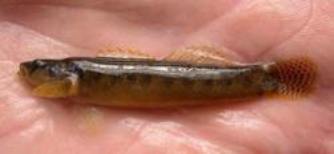Reproduction
The spawning begins in the spring with a male finding a
suitable 'nest'. This usually in shallow
water under flat rocks (Knapp, Roland A.,
and Robert Craig Sargent 1989). Once he finds a spot suitable he waits for a female.
There are a couple observed traits males display that makes them
more desirable to females. Larger males are more likely to mate than their smaller counter
parts. The larger size makes the male more advantageous when it
comes to defending the nest (Moretz, Jason
A., and William Rogers 2004). Females also prefer males that
already have eggs. The fantail darter is a species where the male
tends the eggs, so when a females sees a male already with eggs she
deems him an appropriate protector for future young as well. This
has caused males to evolve egg-mimicry strategies. Many now have
structures that looks like eggs attached to the dorsal fin. While
this has been seen in both sexes, the egg-mimicry is much larger and
more developed among the males versus the females (Knapp,
Roland A., and Robert Craig Sargent 1989).
Sargent 1989). Once he finds a spot suitable he waits for a female.
There are a couple observed traits males display that makes them
more desirable to females. Larger males are more likely to mate than their smaller counter
parts. The larger size makes the male more advantageous when it
comes to defending the nest (Moretz, Jason
A., and William Rogers 2004). Females also prefer males that
already have eggs. The fantail darter is a species where the male
tends the eggs, so when a females sees a male already with eggs she
deems him an appropriate protector for future young as well. This
has caused males to evolve egg-mimicry strategies. Many now have
structures that looks like eggs attached to the dorsal fin. While
this has been seen in both sexes, the egg-mimicry is much larger and
more developed among the males versus the females (Knapp,
Roland A., and Robert Craig Sargent 1989).
When a female then
chooses a male she will deposit her eggs in the nesting area, one or
two at a time, and attach them to the underside of a rock. This can total to between nine to twenty-four eggs.
After she is done the male will release his sperm over the eggs to
fertilize them. While this is happening both sexes exhibit a color
change in parts of their bodies where the lower fins and regions of
the head turn black (Moretz, Jason A., and
William Rogers 2004).
Throughout this process there usually are multiple behaviors
observed. The most common behavior is during the courtship either is
sex will start to quiver in place. There are several hypotheses as
to what this quivering signals or is brought on by. One is that the
female does it to help entice the male and encourage him to
fertilize eggs, and the male quivers for the female to release her
eggs. Another possibility could be that it is caused by the release
of gametes. The second most seen behavior is both sexes will have a
rest period where both will lie on the river bottom facing each
other in no particular way. It also is very common for both the male
and female to lay directly next to one another with their heads
facing the opposite way (Moretz, Jason A.,
and William Rogers 2004).
Once the eggs are fertilized it will take a little less than 35 days
for them to hatch. During this time the male will watch over them
and often resort to filial cannibalism. It is more common among
smaller amounts of eggs that the male will eat all of them, and
males with more eggs are more likely to consume only part of their
offspring. This is thought to be done so that the male can gain
nutrients that he cannot find elsewhere (Lindstrom
K., and R. C. Sargent 1997).